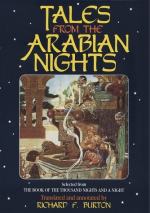[FN#328] Here is the normal enallage of persons, “luh” = to him for “li” = to me.
[FN#329] In text “Na’mil ma’allazi, etc....makidah.” I have attempted to preserve the idiom.
[FN#330] [In the Ms. “al-’Ashrah Miah,” which, I think, can scarcely be translated by “ten times one hundred.” If Miah were dependent on al-’Ashrah, the latter could not have the article. I propose therefore to render “one hundred for the (i.e. every) ten” = tenfold.—St.]
[FN#331] For this “nosebag,” see vols. Ii. 52, and vi. 151, 192.
[FN#332] [Until here the change fromt eh first person into the third, as pointed out in note 2, has been kept up in the Ms.—“He reached the barracks,” “he found,” etc. Now suddenly the gender changes as well, and the tale continues: “And lo, the girl went to them and said,” etc. etc. This looseness of style may, in the mouth of an Eastern Rawi, have an additional dramatic charm for his more eager than critical audience; but it would be intolerable to European readers. Sir Richard has, therefore, very properly substituted the first person all through.—St.]
[FN#333] “Riyal” is from the Span. “Real” = royal (coin): in Egypt it was so named by order of Ali Bey, the Mameluke, in A.H. 1183 (A.D. 1771-72) and it was worth ninety Faddahs = 5 2/5d. The word, however, is still applied to the dollar proper (Maria Theresa), to the Riyal Fransa or five-france piece and to the Span. pillar dollar: the latter is also nicknamed ‘Abu Madfa’” Father of a Cannon (the columns being mistaken for cannons); also the Abu Takah (Father of a Window), whence we obtaint he Europeanised “Patacco” (see Lane, Appendix ii.) and “Pataca,” which Littre confounds with the “Patard” and of which he ignores the origin.
[FN#334] See The Nights, vol. x. 12.
[FN#335] i.e. “pleasant,” “enjoyable”; see “White as milk” opposed to “black as mud,” etc., vol. iv. 140. Here it is after a fashion synonymous with the French nuit blanche.
[FN#336] [The Ms. seems here to read “wa jasad-hu yuhazdimu,” (thus at least the word, would have to be vocalised if it were a quadrilateral verbal form), and of this I cannot make out any sense. I suspect the final syllable is meant for “Dam,” blood, of which a few lines lower down the plural “Dima” occurs. Reamins to account for the characters immediately preceding it. I think that either the upper dot of the Arabic belongs to the first radical instead of the second, reading “yukhirru,” as the fourth or causative form of “kharra yakhurru,” to flow, to ripple, to purl; or that the two dots beneath are to be divided between the first two characters, reading “bajaza.” The latter, it is true, is no dictionary word, but we have found supra p. 176, “muhandiz” for “muhandis,” so here “bajaza” may stand for “bajasa” = gushed forth, used intransitively and transitively. In either case the translation would be “his body was emitting blood freely."-St.]




